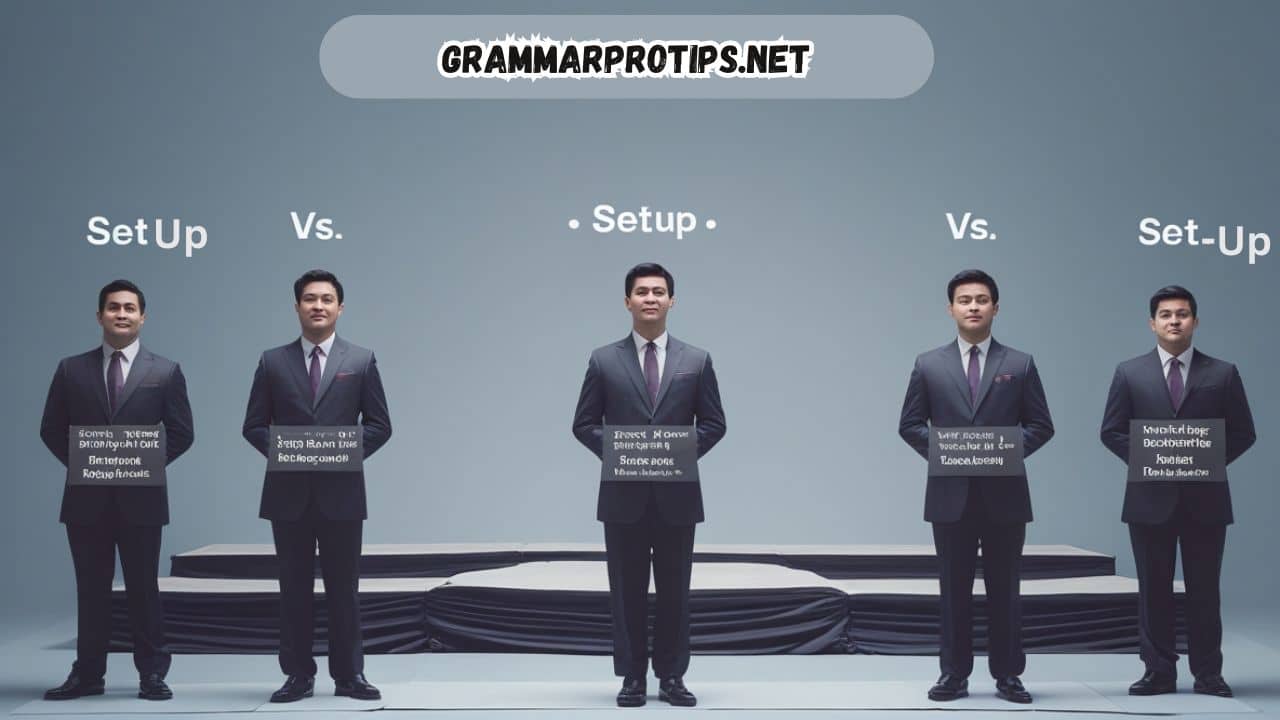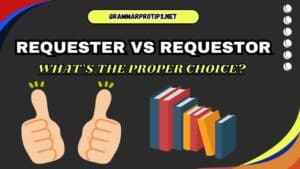The English language is filled with tricky terms that often seem to mean the same thing but have different uses. One such trio of words is set up, setup, and set-up.
While they may look similar, understanding their differences can greatly improve your writing and communication.
In this article, we’ll break down when to use each form, provide clear setup or set up examples, and give you the context to master these words.
The Basics of “Set Up,” “Setup,” and “Set-up”
Before diving into grammar or examples, let’s clarify the differences between these terms:
- Set Up (verb): This refers to the action of arranging, preparing, or organizing something. It’s a verb, meaning it’s used when you’re describing the action. Example:
“I need to set up the projector for tonight’s meeting.” - Setup (noun): This term is used to describe the thing or process that has been organized or arranged. It is a noun and refers to the result of setting up something. Example:
“The setup for the meeting looks great.” - Set-up (noun or adjective): This term can be both a noun and an adjective. As a noun, it refers to the arrangement of things or the way something is set up. As an adjective, it describes something related to an arrangement. Example (noun):
“The set-up of the conference room took several hours.”
Example (adjective):
“He has a well-thought-out set-up plan for the event.”
Set Up vs. Setup vs. Set-up Grammar
When choosing between set up vs setup vs set up grammar, you need to decide whether you’re using a verb or a noun (or adjective). Here’s a quick breakdown:
- Set up is always a verb. It refers to the action of arranging or preparing something. Example (verb):
“She’ll set up the system before the meeting starts.” - Setup is a noun. It refers to the arrangement, the organization, or the system that has been put in place. Example (noun):
“The setup for the new software is almost complete.” - Set-up can be a noun or adjective. As a noun, it refers to an arrangement or configuration, while as an adjective, it describes something related to or characteristic of a setup. Example (noun):
“The set-up of the machines took longer than expected.”
Example (adjective):
“She has a set-up checklist to guide her.”
Set Up vs Setup vs Set-up Examples in Different Contexts
Let’s explore set up vs setup vs set up examples in various scenarios so you can better understand when to use each term.
Scenario 1: Organizing a Meeting (Business Context)
Email Example:
Subject: Set Up a Meeting for Next Week
Dear Emma,
I hope you’re doing well. I’d like to set up a meeting for next week to discuss the upcoming project. Would Thursday afternoon work for you? Once we finalize the time, I will take care of the setup for the meeting, including the room arrangement and equipment.
Looking forward to your response!
Best,
John
Here, set up is used as a verb to describe the action of arranging a meeting. The word setup refers to the physical or logistical arrangement of the meeting.
Scenario 2: Setting Up Technology (Tech Context)
Email Example:
Subject: Account Setup Assistance Needed
Hi Alex,
I understand you’re having trouble with your account setup. I can assist you in the set up process, and we’ll get your account running smoothly in no time. If you need a step-by-step guide, just let me know, and I’ll send it over.
Best regards,
Sarah
In this email, account setup refers to the process or arrangement of creating the account, while set up describes the action of configuring it.
Scenario 3: Scientific Experiment (Academic Context)
Email Example:
Subject: Experimental Set-up for Research
Dear Dr. Brown,
I’ve completed the initial stages of the experimental setup, but I would like to confirm a few adjustments before we proceed. The set-up of the equipment looks good, but I believe we need to make changes to the parameters.
Would you be available to review it with me? Your feedback would be extremely valuable.
Best regards,
Sophia
Here, experimental setup refers to the arrangement of equipment for research, while set-up describes the physical process of configuring the equipment.
When to Use “Set Up” vs. “Setup”
Understanding the differences between set up and setup can be tricky, but it becomes clearer with a few guidelines:
- Use “set up” when you’re talking about the action of preparing, organizing, or arranging something (verb form).
- Example: “Please set up the projector before the meeting.”
- Use “setup” when you’re referring to the thing or process that has been organized or arranged (noun form).
- Example: “The setup for the presentation is complete.”
- Use “set-up” when referring to the noun (the arrangement) or when describing something related to the arrangement (adjective form).
- Example (noun): “The set-up of the new office went smoothly.”
- Example (adjective): “She follows a set-up procedure for handling customer complaints.”
Set Up Past Tense: Understanding “Set Up” in the Past
One area that often causes confusion is the past tense of set up. The past tense of “set up” remains set up, and there’s no change in the form, regardless of whether you’re referring to the past, present, or future.
Example of set up past tense:
“We set up the stage last night for the event.”
As you can see, the past tense form is the same set up.
Set Up Meaning Synonyms: Alternatives to “Set Up”
Sometimes, you might want to use synonyms for set up meaning to vary your language. Here are some alternatives based on the context:
- Arrange: To put something in order or organize it.
- Example: “I will arrange the conference room before the meeting starts.”
- Organize: Often used for more complex arrangements or systems.
- Example: “We need to organize the files before the presentation.”
- Prepare: To make something ready.
- Example: “I will prepare the documents for tomorrow’s meeting.”
- Establish: Often used when setting up something for the first time, like a system.
- Example: “We need to establish a process for onboarding new employees.”
Quick Reference Table: Set Up vs. Setup vs. Set-up
To make things even clearer, here’s a table summarizing the differences between these three terms:
| Term | Part of Speech | Use | Example |
|---|---|---|---|
| Set up | Verb | The action of arranging or preparing something. | “I need to set up the conference room.” |
| Setup | Noun | The process or arrangement that has been organized. | “The setup of the meeting was flawless.” |
| Set-up | Noun/Adjective | A noun describing an arrangement or configuration; or an adjective describing something related to an arrangement. | “The set-up of the experiment was complete.” / “The set-up instructions are clear.” |
Conclusion
In conclusion, understanding the distinctions between set up, setup, and set-up is vital for clear and accurate communication. To quickly recap:
- Set up is always a verb, referring to the action of arranging or preparing something.
- Setup is a noun, referring to the process or arrangement.
- Set-up can be both a noun (the arrangement) and an adjective (describing something related to the arrangement).
By following these simple guidelines and practicing with setup or set up examples, you’ll be able to use these terms with confidence and clarity in your writing.
Read more knowledgeable blogs on Grammar Pro Tips

Sienna Mauldon is a passionate writer and grammar expert. On her blog, she shares easy-to-follow guides to help readers master grammar rules and improve their writing. With a love for language and teaching, Sienna makes grammar simple and fun for everyone, from beginners to experienced writers.








